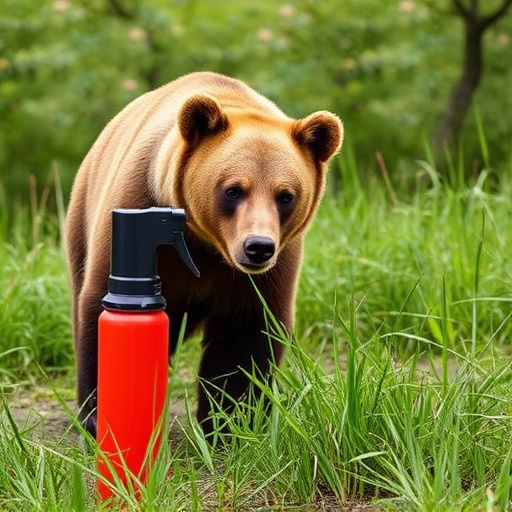Understanding bear behavior is crucial for safe navigation in wild environments. Bear spray, a vital tool, can deter aggressive bears when used correctly, focusing on wind direction (upstream from the bear) to maximize its impact and minimize self-exposure. Key safety tips include staying calm, assessing situations, and learning proper usage before entering bear country. Additional measures like traveling with a partner, making noise, and securing food in bear-resistant containers enhance overall safety in outdoor settings.
In areas where aggressive bears roam, understanding their behavior and taking proactive safety measures are essential. This article guides you through outdoor protection strategies, focusing on bear spray as a critical deterrent. Learn how wind direction plays a role in its effectiveness and discover crucial safety tips for hiking in bear country. Additionally, explore other measures to enhance your protection against these formidable creatures, ensuring a safer outdoor experience.
- Understanding Bear Behavior and Their Aggression Triggers
- The Role of Bear Spray in Deterring Attacks: How It Works
- Assessing Wind Direction for Effective Bear Spray Use
- Essential Safety Tips When Hiking in Bear Country
- Additional Measures for Enhanced Protection Against Bears
Understanding Bear Behavior and Their Aggression Triggers
Understanding bear behavior is crucial when navigating wild environments. Bears are often perceived as aggressive, but their actions are typically driven by instinct and survival. Knowing what triggers their aggression can help hikers and campers avoid dangerous encounters. One key factor is bear spray: this can be an effective deterrent when used correctly, keeping bears at bay during unexpected close encounters.
The wind direction plays a vital role in safety tips for dealing with aggressive bears. Bear spray works best when applied into the face of an approaching bear, and the wind should be behind you to ensure the spray blows towards the bear. If you find yourself facing a bear, remember to stay calm, assess the situation, and use bear spray as a last resort. Always carry it in an easily accessible location and familiarize yourself with its usage before venturing into bear country.
The Role of Bear Spray in Deterring Attacks: How It Works
Bear spray is a crucial tool for outdoor enthusiasts and individuals navigating bear country. Its primary purpose is to deter aggressive bears and provide a layer of protection when faced with an encounter. When used correctly, bear spray can significantly reduce the risk of attacks by temporarily blinding and disorienting bears, giving you valuable time to retreat or defend yourself.
The effectiveness of bear spray relies heavily on understanding the wind direction safety tips. Spraying directly into the face of a bear is unlikely to be successful; instead, aim for the bear’s eyes, nose, and mouth. The wind should be blowing away from you, ensuring that the spray doesn’t blow back onto your own face or body. Proper usage involves spraying in quick bursts and staying calm during an encounter, as this increases the likelihood of a successful deterrence.
Assessing Wind Direction for Effective Bear Spray Use
When preparing for encounters with aggressive bears in the outdoors, understanding wind direction plays a pivotal role in ensuring the effectiveness of your bear spray. Prior to spraying, assess the breeze’s direction to maximize its impact on the bear while minimizing exposure for yourself. A general rule is to apply the spray towards the bear’s face and head from an upstream position, allowing the wind to carry the spray directly onto the target.
This technique leverages the natural airflow, ensuring that you don’t waste valuable bear spray and increasing your safety margin. Additionally, staying upwind reduces the risk of inhaling the spray yourself or creating a potential fire hazard in the event of a spark from the can. Bear spray wind direction safety tips emphasize this upstream positioning to make every spray application count during encounters with these formidable creatures.
Essential Safety Tips When Hiking in Bear Country
When venturing into bear country, prioritizing safety is paramount. Always carry bear spray as a primary defense mechanism. This potent deterrent can create a buffer zone between you and an encounter, allowing for a safe escape. Understand the wind direction before setting out; carrying it in front of you and aimed away from your body, ensures its effectiveness should a bear approach unexpectedly.
Adhering to specific hiking practices enhances safety. Stay in well-traveled areas, make noise to avoid surprising bears, and carry food securely in bear-resistant containers. By following these essential safety tips, hikers can minimize the risk of dangerous encounters while enjoying the beauty of nature responsibly.
Additional Measures for Enhanced Protection Against Bears
In addition to carrying bear-repellent food containers and making noise while hiking, there are several safety tips and measures to enhance protection against aggressive bears. One effective tool is bear spray, which can create a barrier between you and the bear. When using bear spray, remember to follow the wind direction; hold the canister at knee height and aim towards the bear’s face from the side or behind. Always keep bear spray readily accessible and ensure it’s properly stored for easy retrieval during an encounter.
Understanding the wind direction is crucial as it can determine the effectiveness of your defenses. If possible, hike with a partner to increase visibility and safety. Stay alert, make regular noise, and travel in groups whenever hiking in bear country. By combining these additional measures, you can significantly reduce the risk of unexpected bear encounters and enhance your overall safety in outdoor settings.
Understanding bear behavior and knowing how to respond is key to staying safe in areas with aggressive bears. While bear spray is an effective deterrent, proper usage depends on understanding wind direction. Always follow safety tips when hiking in bear country, such as making noise to avoid unexpected encounters, traveling in groups, and storing food securely. Combining these measures with additional protective gear can significantly reduce the risk of dangerous bear interactions, ensuring a safer outdoor experience.
